Dan Green
 1 comment
1 comment

Image Credit: John Taylor For almost ten years having decoded cryptic clues stored at Rennes-le-Chateau in France that led over to England, I have shared my discovery of a location opposite the South East corner of Lincoln Cathedral whose own architectural anomalies within reinforces the suggestion that here resides a buried ‘treasure’ relating to the mystery of Mary Magdalene. To my surprise I have now been alerted to another unresolved coded mystery elsewhere in England, first noticed by author Graham Phillips, which again appears to be leading us to my already ‘X marks the spot’ and concluding marker tomb, associated with the number 28, at the burial grounds of St Margaret.
In the rural Warwickshire countryside ‘A discovery of immense importance’ has been awaiting us for the last 107 years at a window in a chapel in the small village of Langley, a few miles away from Shakespeare’s own Holy Trinity church containing his tomb and its curse, placed there by its once owner Jacob Cove-Jones, a secret hiding within a small parish church whose village name unconsciously hides the anagram ‘Angle ley’, significant as areas of this research, I have found, involve ley lines and earth energies.
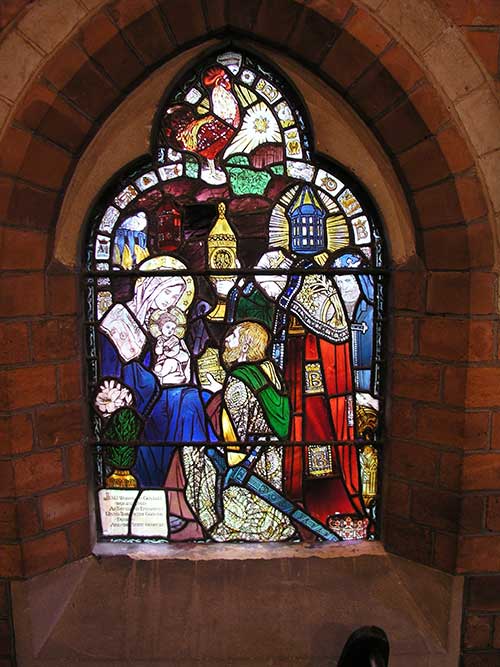
The Epiphany Window (Reproduced by permission of Graham Phillips)
In 1835 Poet Laureate Lord Tennyson, a key figure in the Lincoln location, published a poem containing references to Orion and the Pleiades in his ‘Locksley Hall’ and in the 1850’s Cove-Jones purchased his Loxley House, likening it to ‘Loxley Hall’. Since he had a church already on this estate one might ask why he should place his Epiphany window in a chapel seven miles away unless the location had some unsuspected significance, this being that the window is looking South and at just five miles in this direction is the Shakespeare church of Holy Trinity which when viewed from Langley at midnight on Epiphany 1907, the year the window was installed, Orion and the Winter Triangle, containing Sirius, would be viewed in the heavens above it.
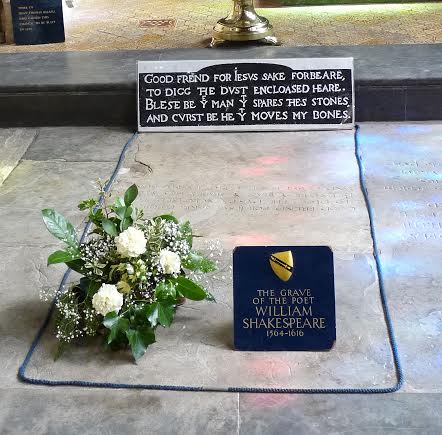
Shakespeare’s accursed tomb
The Langley stain glass scene showing the twelfth night of Christmas Epiphany contains a rooster, or cock, a bright star and the three wise men. A kneeling figure at the front of the scene looks very like the St George figure in the window of Shakespeare’s church window at Holy Trinity. The epiphany scene presumes to show us that taken from the 1857 ‘We three kings of orient are’, the well-known Christmas carol.
If we take a look at the female and child in the depiction we can see that the appearance of the child is arguably female. Above the mother’s head is a red light indicating the term associated to urban areas with a concentration of prostitution, meeting with the character assassination of one female in particular, that of Mary Magdalene. There is even a further allusion provided by the Collective Unconscious to present us with another ‘Three kings’ for on the night of epiphany in 1907 directly over the head of Orion was Pluto (god of the Underworld) with both Jupiter (Zeus, King of the gods) and Neptune (Poseidon, God of the sea) over his left shoulder – the Three Great ‘Kings’.
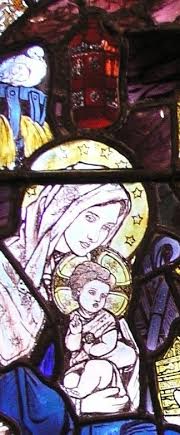
Magdalene and child?
Considering we are at the Nativity we see no presence of either father Joseph or animals suggesting that this is not really the regular account of the birth of Jesus – no father means the female is not the Virgin Mary with new born. To the right of the mother and child stands a shepherd’s crook with no owner – a hint that will lead us back to the Virgin-martyr shepherdess St Margaret, prime figure in the Lincoln Cathedral Code location.
One panel directly above and one to the left of the head of whom I feel is Mary Magdalene, appear to confirm my suspicion, both containing the letter ‘M’ with a crown on top of it. Together we have ‘MM’. Clues that draw attention to Shakespeare’s own church appear when we notice that Epiphany is the 12th night after Christmas, a time traditional for tomfoolery, servants dressing as their masters and gender role reversals, men dressing as women and vice versa. Leading us to Shakespeare’s 1601-2 comedy ‘12th Night’, the plot has a lady disguised as a man in search of her missing brother, perhaps telling us here that our interest should be in locating a female with a Christ association, rather than male – the Magdalene.
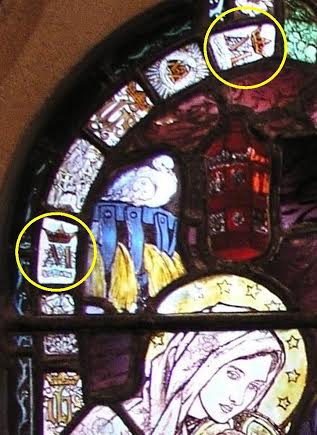
The Two M’s – Mary Magdalene
At the bottom of the window is an inscription that starts with, ‘Jesu whom’ before the lead casing breaks up the line. A hint that we are in pursuit of somebody who has the most intimate Jesus connection – a female who has a womb? Within the name of one of the characters in the play, Orsiono, we find ‘Orion’.
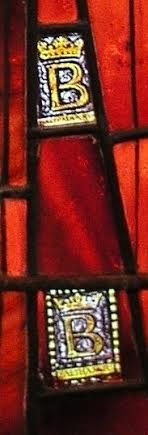
To Be or Not To Be – The two B’s
Alluding again to the works of the Bard of Avon, on the cloak of the middle king there are two ‘B’s – ‘To be or not to be’ – spoken in the tragedy play Hamlet during 1599-1602. The ‘B’ with a crown above it refers us to the Queen Bee, an epithet of the Mother Goddess archetype of whose current conscious manifestation is the Magdalene. Above the illustration of a dove are two small panels of which the top one contains the lettering ‘IHS’ often a monogram for Christ but in this instance both ‘I’ and ‘H’ blend into each other, providing us with a new monogram ‘WS’ for William Shakespeare.
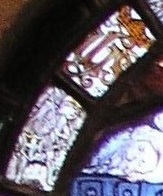
‘IHS’ or is it ‘WS’, William Shakespeare?
The figure in the panel below is wielding a spear, is this a member of the secretive ‘Spear Shakers’, a gathering of Tudor writers, poets and actors who, led by Francis Tudor Bacon, who had an interest in all things esoteric and to whom, some allege, wrote vast works of literature penned as ‘William Shakespeare’, taking it in turns to dress as their fictional figure and members of his family to appear in public to promote him as a real figure?
The five pointed Epiphany star flies in the face of the six-pointed star of Bethlehem for it is the five pointed bright and morning star of our canine conundrum Sirius, brightest star in the night sky and known as ‘The bright and morning star’, classically depicted as Orion’s Dog. An icon of Sirius as a five pointed star has been found on the walls of the famous temple of Isis/Hathor at Dendera in Egypt and in Egyptian mythology Sopdet, deification of Sothis (Sirius), is depicted as a woman with a five pointed star upon her head. The average date for Matthew’s Gospel account of the announcement of the birth of Jesus in relation to a star in the East and the Magi was 50AD. The sky at sunset on 25th December that year, seen from the latitude of Alexandria, has the three stars of Orion’s Belt rising in the East, thus heralding the arrival of the birth star Sirius which would follow no more than one hour later.
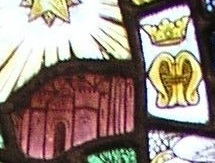
Lincoln Castle and Cathedral?
The tile directly under the star shows a specific architecture, depicted sloping upwards to implying different levels as if on a hill, a place with a Cathedral and a Castle facing each other, both with arched entrances below twin towers – Lincoln Cathedral and Castle. The tile adjacent and attached to the Cathedral-Castle has an ‘M’ in gold. A glass pane at the Holy Trinity church depicting St Margaret is the odd one out also as she is the only figure there among three where the ‘M’ is in gold.
The top of the window reads, ‘Arise shine light on me’, the nearby rooster at the top would crow at dawn, the time we would expect to see the bright and morning star rising. The ‘Morning Star’ is a 1781 public house close to Lincoln Cathedral and the church of St Peter, which we will now look at.
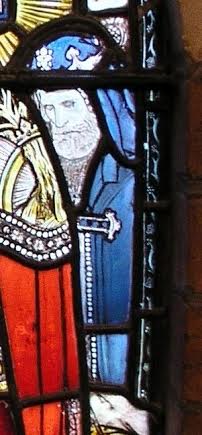
St Peter hints at his church in Eastgate, Lincoln
If we decide to view the Epiphany window as a map starting with North at the top, then the bearded, dressed in blue, third king, who by being shown in this fashion resembles the usual portrayal of St Peter, would be located in the East. St Peter church in Lincoln, firstly an 11th century church before falling in ruination, is no distance away from the Cathedral and St Margaret’s burial grounds. It had been quietly acknowledged as being ‘The Freemasons Church, the foundation stone, after the second 1781 church was built (that year again!), laid in 1869 by a member of Witham Masonic lodge in Lincoln by public subscription, mostly from Freemasons, and even having a corner stone laying ceremony.
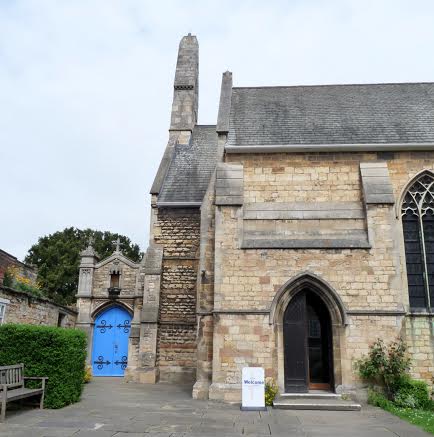
St Peter church, Eastgate, Lincoln
A confidante has informed me that the current curator cleric who took over in 2003, aware of, in his estimation, its undesirable history, took an intense dislike to and openly disposed of the lectern that had Masonic symbology carved upon it, hiding it away, and has stopped Freemasons holding private services there as they had no doubt historically. Upon the door of this Freemasonic St Peter is the perpetually maintained shade of blue worn by our blue king. At the Last Supper it is Peter who is at the left of Christ and in our portrayal we find him to the left of the Christ child. Traditionally we are to know this St Peter as Gatekeeper holding the keys of Heaven and Hell, but in our mystery he is guarding the gates that stand firm in the east, for the Lincoln Freemasonic church is located at St Peter-in-Eastgate.
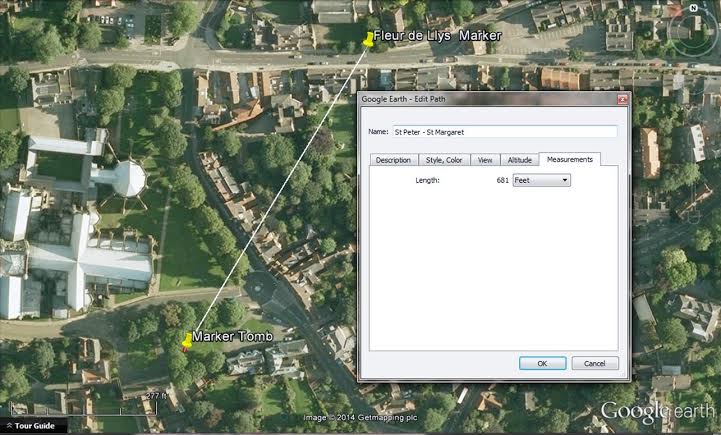
St Peter to Marker tomb – exactly 681’ apart ( Image Credit: Google Earth )
Our map shows the Magdalene with red lamp and crook of St Margaret to the south west of Peter. Drawing a path in Google Earth and clicking to get measurements, it was found that the distance from the Fleur de Lys marker upon St Peters church and the St Margaret’s burial grounds Marker tomb is exactly 681 feet or ‘paces’…the encrypted ‘Pace 681’ mentioned in one of the premier clues alluded to at Rennes-le-Chateau.
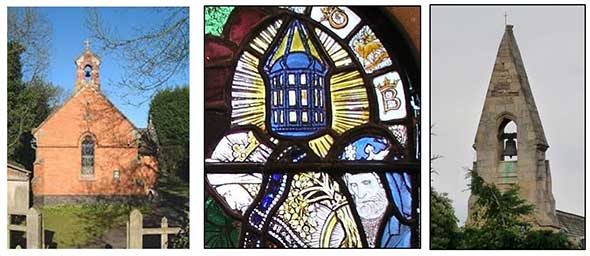
Bellcote ‘Lamps’ at Langley and Lincoln with St Peter’s lamp in middle
If we liken the blue lamp above St Peter in the East also to a bell, a reference to a church with a bell cote – a bell gable or framework for hanging a bell or bells – we discover that at both Langley chapel and at St Peters in Lincoln there is a bell cote at the east end of the roof, the surroundings of the lamp even appear to make the arch shape of a bell cote. Our other lamp/bell in the west would therefore resemble the bell cote hanging above the red brick of the Langley chapel. Here we link both St Peter’s in Lincoln with the Warwickshire chapel. Below St Peter and red cloaked king, we see the anomalous small dog that appears on the platter at the Last Supper at Lincoln Cathedral’s Great East Window.
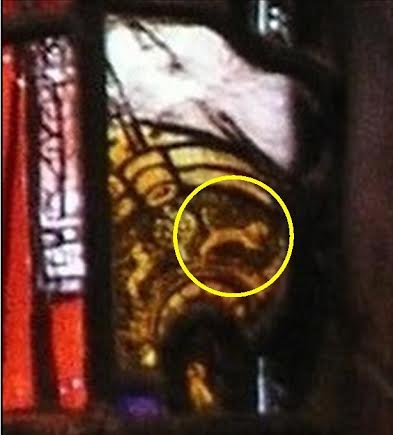
Lincoln Cathedral’s dog on the platter, at Langley!
Three small panes around the edges of the window show us white five-petalled roses which we find at the Lord Tennyson statue and also in Shakespeare’s church, where we will return to in Stratford-upon-Avon.
The stain glass windows at the North wall depicts three people – all with identical faces – to the right St Ethelreda and on the left, St Bride. At the centre of this trinity is a regal looking Margaret in Magdalene red robed, holding a cross in her right hand and a golden sceptre and a book in her left. A Patron Saint of pregnant women and women in childbirth, her initials have her ‘S’ in silver and in front of this her ‘M’ in gold, the two other saints having their initials written in the same colour and displayed equally.
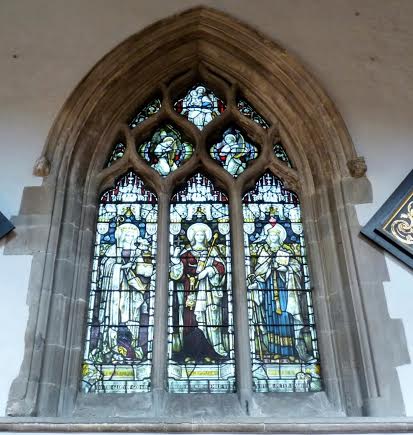
St Margaret’s window, Shakespeare’s church
The forefingers of her left hand and the angle of her sceptre points to a gold purse hanging from her belt. The angle of her sceptre is the same as the line of the Fosse Way, the Roman road that linked Exeter to Lincoln, which is also the angle of the summer solstice sunrise and winter solstice sunset. Resembling an arrow, the top of the sceptre points to Lincoln. In the centre of the sceptre, the book is equidistant as is Stratford-upon-Avon between Glastonbury and Lincoln. Her cross may be a representation of the constellation of Cygnus, the Latinized Greek word for ‘Swan’, which has been discovered to topographically reflect on the ground the surrounds of Lincoln city. The primary emblem of St Hugh, the Patron Saint of Lincoln Cathedral, was a white swan with which he had a deep and lasting friendship. Underneath Margaret is the inscription;
"St Margaret
Honoured memory * of Emilie * Vick"
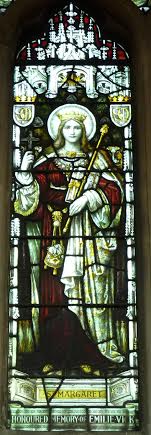
St Margaret and clues
Ignoring the characters in a different case and taking into account symbols between words, if we count the dots as a character we find 28 in the bottom line, giving us an alternative reading of the inscription; ‘St Margaret 28’ – the number of the Marker tomb within her Lincoln burial grounds.
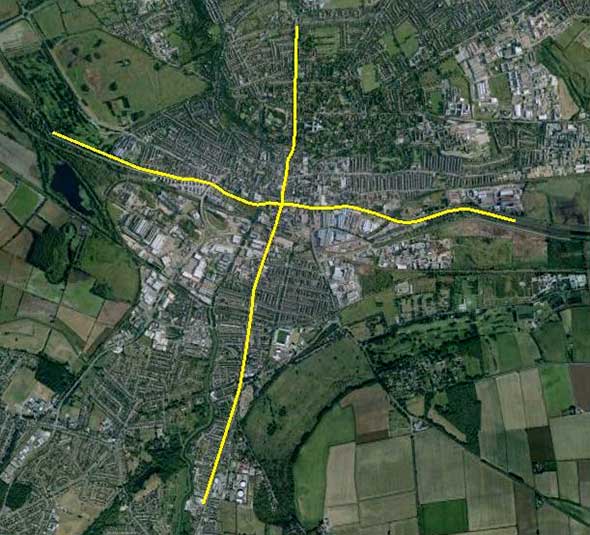
Lincoln city reflects the constellation of Cygnus – Jesus on the Cross ( Image Credit: Google Earth )
Dressed like a nun and wearing a crown with a red flame above, St Ethelreda in her panel of the window emulates both other saints with white cloak trimmed with gold, holds a bunch of white flowers in her right hand pointing to her initials SE, in her left hand a beautiful white and gold bound book. Her image strays from the usual where she will be seen holding a cathedral. With the written sometime between 1590-96 Shakespeare ‘Midsummer Night’s Dream’ in mind, note that there is only three days difference in the Feast dates for both Margaret (20th June) and Ethelreda (23rd), the dates the summer solstice always takes place between, so the proximity of both these saints and the angle of Margaret’s sceptre seem to be highlighting this time of year.
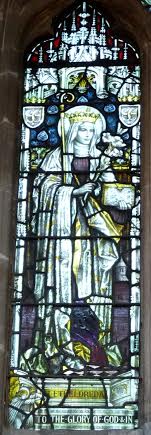
St Ethelreda – The Red Lade
Mary Magdalene is known as the ‘Red Lady’ and a phonetic anagram of Ethelreda provides us with ‘The Red Lade’. This stain glass Ethelreda gives us a set of three clues; Her association with a Cathedral (missing here), a red lady, and a SE or South-east, the very corner where at Lincoln Cathedral we enter the graveyard of St Margaret to find our Marker tomb. The inscription under her feet contains 33 characters, this being the number in Freemasonry that informs us to be vigilant for clues.
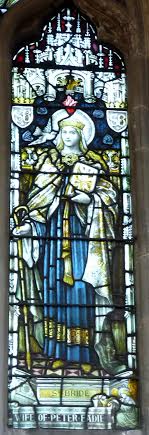
St Bride
Onto St Bride dressed in blue, holding shepherds crook in her right hand and, like the other two saints, a book in her left. In her blue robe reminding us of the mother in the Epiphany map, her title of ’Bride’ is more likely to be hinting us that this is not the Virgin Mary but Mary Magdalene the alleged bride of Jesus. The Epiphany lady dressed in blue has a red lamp over her head, a dove sitting above her right shoulder and a shepherdess’ crook near to her left.
Looking facially like the Epiphany mother, Bride, a Patron Saint of babies and illegitimate births and midwives, is dressed in blue, a dove flying towards her face, and she holds a shepherdess crook. The blue robe duplicates the same robe worn by St Peter and the colour shade of the door at his church in Lincoln. Bride, too, has an inscription at her feet;
"St BRIDE WIFE OF * PETER * EADIE
….of which the hidden anagram is; ‘BRIDE OF PETER EAST WIFE DIE’"
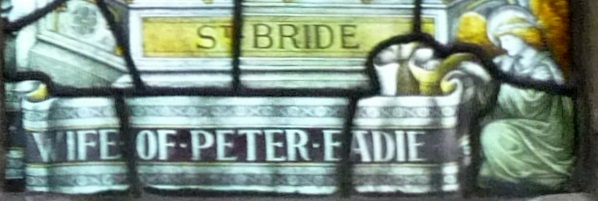
St Bride’s coded inscription
Now allow me to explain how we can interpret this coded inscription as it was meant. Our Cathedral Code St Margaret’s church was demolished in 1781 and that year there was the amalgamation of Margaret-In-The-Close with the parish of St Peter-In-Eastgate, our concealed Freemasonic church, thus St Margaret became the WIFE or BRIDE of St Peter in EAST Gate, the WIFE, with the demolition of her church, Die (d). If we take a look at the crook held by St Bride we see it points up to the word ‘WIFE’ for not only are we to receive this understanding of St Margaret becoming the bride of St Peter but it also serves to remind us of the previously held secret that Mary Magdalene was once thought to have been the BRIDE of Christ.
There is yet still more to share as we travel along the Fosse way and back to St Peters-in-Eastgate at Lincoln and to the East wall of the church to a window which is part of the south aisle sitting above a side altar dedicated to St Margaret. The window above the St Margaret altar has five panels but she herself is noticeable by her absence. Although she can be located in the Holy Trinity church on a plinth as a statue should, back in the porch of St Peters church in Lincoln the plinth is empty, above it the wording;
"‘S MARGARET’"
Carved adornments above the plinth closely resemble those above the image of Margaret at Holy Trinity. There is a small picture of Christ dressed in red but cloaked in blue sitting on the plinth at St Peters, a subtlety that may suggest that by finding St Margaret – or her burial grounds – we may also find a Christ connection with Mary Magdalene.
And so, not only do clues at Rennes-le-Chateau lead us to a precise location at Lincoln but it appears so do others not only from a small and relatively insignificant chapel in Warwickshire, but with assistance from the famous church and that of the controversial, enigmatic figure of Shakespeare himself.
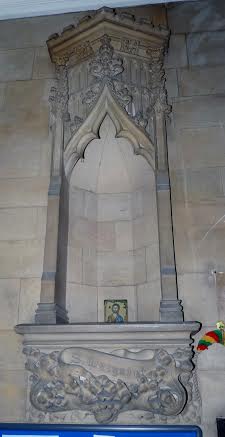
Margaret missing on her plinth
Dan's book, "The Murder of Mary Magdalene -Synchronicity and the Scarlet Saint" is available now at Amazon:
http://www.amazon.co.uk/The-Murder-Mary-Magdalene-Synchronicity/dp/1907126147/
His new book, "Activation Code Earth", is available to download as a free ebook from http://www.dangreencodex.co.uk/ Comments (1)
Shakespeare and the Magdalene
September 22, 2014 | 1 comment
1 comment

Image Credit: John Taylor For almost ten years having decoded cryptic clues stored at Rennes-le-Chateau in France that led over to England, I have shared my discovery of a location opposite the South East corner of Lincoln Cathedral whose own architectural anomalies within reinforces the suggestion that here resides a buried ‘treasure’ relating to the mystery of Mary Magdalene. To my surprise I have now been alerted to another unresolved coded mystery elsewhere in England, first noticed by author Graham Phillips, which again appears to be leading us to my already ‘X marks the spot’ and concluding marker tomb, associated with the number 28, at the burial grounds of St Margaret.
In the rural Warwickshire countryside ‘A discovery of immense importance’ has been awaiting us for the last 107 years at a window in a chapel in the small village of Langley, a few miles away from Shakespeare’s own Holy Trinity church containing his tomb and its curse, placed there by its once owner Jacob Cove-Jones, a secret hiding within a small parish church whose village name unconsciously hides the anagram ‘Angle ley’, significant as areas of this research, I have found, involve ley lines and earth energies.

The Epiphany Window (Reproduced by permission of Graham Phillips)
In 1835 Poet Laureate Lord Tennyson, a key figure in the Lincoln location, published a poem containing references to Orion and the Pleiades in his ‘Locksley Hall’ and in the 1850’s Cove-Jones purchased his Loxley House, likening it to ‘Loxley Hall’. Since he had a church already on this estate one might ask why he should place his Epiphany window in a chapel seven miles away unless the location had some unsuspected significance, this being that the window is looking South and at just five miles in this direction is the Shakespeare church of Holy Trinity which when viewed from Langley at midnight on Epiphany 1907, the year the window was installed, Orion and the Winter Triangle, containing Sirius, would be viewed in the heavens above it.

Shakespeare’s accursed tomb
The Langley stain glass scene showing the twelfth night of Christmas Epiphany contains a rooster, or cock, a bright star and the three wise men. A kneeling figure at the front of the scene looks very like the St George figure in the window of Shakespeare’s church window at Holy Trinity. The epiphany scene presumes to show us that taken from the 1857 ‘We three kings of orient are’, the well-known Christmas carol.
If we take a look at the female and child in the depiction we can see that the appearance of the child is arguably female. Above the mother’s head is a red light indicating the term associated to urban areas with a concentration of prostitution, meeting with the character assassination of one female in particular, that of Mary Magdalene. There is even a further allusion provided by the Collective Unconscious to present us with another ‘Three kings’ for on the night of epiphany in 1907 directly over the head of Orion was Pluto (god of the Underworld) with both Jupiter (Zeus, King of the gods) and Neptune (Poseidon, God of the sea) over his left shoulder – the Three Great ‘Kings’.

Magdalene and child?
Considering we are at the Nativity we see no presence of either father Joseph or animals suggesting that this is not really the regular account of the birth of Jesus – no father means the female is not the Virgin Mary with new born. To the right of the mother and child stands a shepherd’s crook with no owner – a hint that will lead us back to the Virgin-martyr shepherdess St Margaret, prime figure in the Lincoln Cathedral Code location.
One panel directly above and one to the left of the head of whom I feel is Mary Magdalene, appear to confirm my suspicion, both containing the letter ‘M’ with a crown on top of it. Together we have ‘MM’. Clues that draw attention to Shakespeare’s own church appear when we notice that Epiphany is the 12th night after Christmas, a time traditional for tomfoolery, servants dressing as their masters and gender role reversals, men dressing as women and vice versa. Leading us to Shakespeare’s 1601-2 comedy ‘12th Night’, the plot has a lady disguised as a man in search of her missing brother, perhaps telling us here that our interest should be in locating a female with a Christ association, rather than male – the Magdalene.

The Two M’s – Mary Magdalene
At the bottom of the window is an inscription that starts with, ‘Jesu whom’ before the lead casing breaks up the line. A hint that we are in pursuit of somebody who has the most intimate Jesus connection – a female who has a womb? Within the name of one of the characters in the play, Orsiono, we find ‘Orion’.

To Be or Not To Be – The two B’s
Alluding again to the works of the Bard of Avon, on the cloak of the middle king there are two ‘B’s – ‘To be or not to be’ – spoken in the tragedy play Hamlet during 1599-1602. The ‘B’ with a crown above it refers us to the Queen Bee, an epithet of the Mother Goddess archetype of whose current conscious manifestation is the Magdalene. Above the illustration of a dove are two small panels of which the top one contains the lettering ‘IHS’ often a monogram for Christ but in this instance both ‘I’ and ‘H’ blend into each other, providing us with a new monogram ‘WS’ for William Shakespeare.

‘IHS’ or is it ‘WS’, William Shakespeare?
The figure in the panel below is wielding a spear, is this a member of the secretive ‘Spear Shakers’, a gathering of Tudor writers, poets and actors who, led by Francis Tudor Bacon, who had an interest in all things esoteric and to whom, some allege, wrote vast works of literature penned as ‘William Shakespeare’, taking it in turns to dress as their fictional figure and members of his family to appear in public to promote him as a real figure?
The five pointed Epiphany star flies in the face of the six-pointed star of Bethlehem for it is the five pointed bright and morning star of our canine conundrum Sirius, brightest star in the night sky and known as ‘The bright and morning star’, classically depicted as Orion’s Dog. An icon of Sirius as a five pointed star has been found on the walls of the famous temple of Isis/Hathor at Dendera in Egypt and in Egyptian mythology Sopdet, deification of Sothis (Sirius), is depicted as a woman with a five pointed star upon her head. The average date for Matthew’s Gospel account of the announcement of the birth of Jesus in relation to a star in the East and the Magi was 50AD. The sky at sunset on 25th December that year, seen from the latitude of Alexandria, has the three stars of Orion’s Belt rising in the East, thus heralding the arrival of the birth star Sirius which would follow no more than one hour later.

Lincoln Castle and Cathedral?
The tile directly under the star shows a specific architecture, depicted sloping upwards to implying different levels as if on a hill, a place with a Cathedral and a Castle facing each other, both with arched entrances below twin towers – Lincoln Cathedral and Castle. The tile adjacent and attached to the Cathedral-Castle has an ‘M’ in gold. A glass pane at the Holy Trinity church depicting St Margaret is the odd one out also as she is the only figure there among three where the ‘M’ is in gold.
The top of the window reads, ‘Arise shine light on me’, the nearby rooster at the top would crow at dawn, the time we would expect to see the bright and morning star rising. The ‘Morning Star’ is a 1781 public house close to Lincoln Cathedral and the church of St Peter, which we will now look at.

St Peter hints at his church in Eastgate, Lincoln
If we decide to view the Epiphany window as a map starting with North at the top, then the bearded, dressed in blue, third king, who by being shown in this fashion resembles the usual portrayal of St Peter, would be located in the East. St Peter church in Lincoln, firstly an 11th century church before falling in ruination, is no distance away from the Cathedral and St Margaret’s burial grounds. It had been quietly acknowledged as being ‘The Freemasons Church, the foundation stone, after the second 1781 church was built (that year again!), laid in 1869 by a member of Witham Masonic lodge in Lincoln by public subscription, mostly from Freemasons, and even having a corner stone laying ceremony.

St Peter church, Eastgate, Lincoln
A confidante has informed me that the current curator cleric who took over in 2003, aware of, in his estimation, its undesirable history, took an intense dislike to and openly disposed of the lectern that had Masonic symbology carved upon it, hiding it away, and has stopped Freemasons holding private services there as they had no doubt historically. Upon the door of this Freemasonic St Peter is the perpetually maintained shade of blue worn by our blue king. At the Last Supper it is Peter who is at the left of Christ and in our portrayal we find him to the left of the Christ child. Traditionally we are to know this St Peter as Gatekeeper holding the keys of Heaven and Hell, but in our mystery he is guarding the gates that stand firm in the east, for the Lincoln Freemasonic church is located at St Peter-in-Eastgate.

St Peter to Marker tomb – exactly 681’ apart ( Image Credit: Google Earth )
Our map shows the Magdalene with red lamp and crook of St Margaret to the south west of Peter. Drawing a path in Google Earth and clicking to get measurements, it was found that the distance from the Fleur de Lys marker upon St Peters church and the St Margaret’s burial grounds Marker tomb is exactly 681 feet or ‘paces’…the encrypted ‘Pace 681’ mentioned in one of the premier clues alluded to at Rennes-le-Chateau.

Bellcote ‘Lamps’ at Langley and Lincoln with St Peter’s lamp in middle
If we liken the blue lamp above St Peter in the East also to a bell, a reference to a church with a bell cote – a bell gable or framework for hanging a bell or bells – we discover that at both Langley chapel and at St Peters in Lincoln there is a bell cote at the east end of the roof, the surroundings of the lamp even appear to make the arch shape of a bell cote. Our other lamp/bell in the west would therefore resemble the bell cote hanging above the red brick of the Langley chapel. Here we link both St Peter’s in Lincoln with the Warwickshire chapel. Below St Peter and red cloaked king, we see the anomalous small dog that appears on the platter at the Last Supper at Lincoln Cathedral’s Great East Window.

Lincoln Cathedral’s dog on the platter, at Langley!
Three small panes around the edges of the window show us white five-petalled roses which we find at the Lord Tennyson statue and also in Shakespeare’s church, where we will return to in Stratford-upon-Avon.
The stain glass windows at the North wall depicts three people – all with identical faces – to the right St Ethelreda and on the left, St Bride. At the centre of this trinity is a regal looking Margaret in Magdalene red robed, holding a cross in her right hand and a golden sceptre and a book in her left. A Patron Saint of pregnant women and women in childbirth, her initials have her ‘S’ in silver and in front of this her ‘M’ in gold, the two other saints having their initials written in the same colour and displayed equally.

St Margaret’s window, Shakespeare’s church
The forefingers of her left hand and the angle of her sceptre points to a gold purse hanging from her belt. The angle of her sceptre is the same as the line of the Fosse Way, the Roman road that linked Exeter to Lincoln, which is also the angle of the summer solstice sunrise and winter solstice sunset. Resembling an arrow, the top of the sceptre points to Lincoln. In the centre of the sceptre, the book is equidistant as is Stratford-upon-Avon between Glastonbury and Lincoln. Her cross may be a representation of the constellation of Cygnus, the Latinized Greek word for ‘Swan’, which has been discovered to topographically reflect on the ground the surrounds of Lincoln city. The primary emblem of St Hugh, the Patron Saint of Lincoln Cathedral, was a white swan with which he had a deep and lasting friendship. Underneath Margaret is the inscription;
"St Margaret
Honoured memory * of Emilie * Vick"

St Margaret and clues
Ignoring the characters in a different case and taking into account symbols between words, if we count the dots as a character we find 28 in the bottom line, giving us an alternative reading of the inscription; ‘St Margaret 28’ – the number of the Marker tomb within her Lincoln burial grounds.

Lincoln city reflects the constellation of Cygnus – Jesus on the Cross ( Image Credit: Google Earth )
Dressed like a nun and wearing a crown with a red flame above, St Ethelreda in her panel of the window emulates both other saints with white cloak trimmed with gold, holds a bunch of white flowers in her right hand pointing to her initials SE, in her left hand a beautiful white and gold bound book. Her image strays from the usual where she will be seen holding a cathedral. With the written sometime between 1590-96 Shakespeare ‘Midsummer Night’s Dream’ in mind, note that there is only three days difference in the Feast dates for both Margaret (20th June) and Ethelreda (23rd), the dates the summer solstice always takes place between, so the proximity of both these saints and the angle of Margaret’s sceptre seem to be highlighting this time of year.

St Ethelreda – The Red Lade
Mary Magdalene is known as the ‘Red Lady’ and a phonetic anagram of Ethelreda provides us with ‘The Red Lade’. This stain glass Ethelreda gives us a set of three clues; Her association with a Cathedral (missing here), a red lady, and a SE or South-east, the very corner where at Lincoln Cathedral we enter the graveyard of St Margaret to find our Marker tomb. The inscription under her feet contains 33 characters, this being the number in Freemasonry that informs us to be vigilant for clues.

St Bride
Onto St Bride dressed in blue, holding shepherds crook in her right hand and, like the other two saints, a book in her left. In her blue robe reminding us of the mother in the Epiphany map, her title of ’Bride’ is more likely to be hinting us that this is not the Virgin Mary but Mary Magdalene the alleged bride of Jesus. The Epiphany lady dressed in blue has a red lamp over her head, a dove sitting above her right shoulder and a shepherdess’ crook near to her left.
Looking facially like the Epiphany mother, Bride, a Patron Saint of babies and illegitimate births and midwives, is dressed in blue, a dove flying towards her face, and she holds a shepherdess crook. The blue robe duplicates the same robe worn by St Peter and the colour shade of the door at his church in Lincoln. Bride, too, has an inscription at her feet;
"St BRIDE WIFE OF * PETER * EADIE
….of which the hidden anagram is; ‘BRIDE OF PETER EAST WIFE DIE’"

St Bride’s coded inscription
Now allow me to explain how we can interpret this coded inscription as it was meant. Our Cathedral Code St Margaret’s church was demolished in 1781 and that year there was the amalgamation of Margaret-In-The-Close with the parish of St Peter-In-Eastgate, our concealed Freemasonic church, thus St Margaret became the WIFE or BRIDE of St Peter in EAST Gate, the WIFE, with the demolition of her church, Die (d). If we take a look at the crook held by St Bride we see it points up to the word ‘WIFE’ for not only are we to receive this understanding of St Margaret becoming the bride of St Peter but it also serves to remind us of the previously held secret that Mary Magdalene was once thought to have been the BRIDE of Christ.
There is yet still more to share as we travel along the Fosse way and back to St Peters-in-Eastgate at Lincoln and to the East wall of the church to a window which is part of the south aisle sitting above a side altar dedicated to St Margaret. The window above the St Margaret altar has five panels but she herself is noticeable by her absence. Although she can be located in the Holy Trinity church on a plinth as a statue should, back in the porch of St Peters church in Lincoln the plinth is empty, above it the wording;
"‘S MARGARET’"
Carved adornments above the plinth closely resemble those above the image of Margaret at Holy Trinity. There is a small picture of Christ dressed in red but cloaked in blue sitting on the plinth at St Peters, a subtlety that may suggest that by finding St Margaret – or her burial grounds – we may also find a Christ connection with Mary Magdalene.
And so, not only do clues at Rennes-le-Chateau lead us to a precise location at Lincoln but it appears so do others not only from a small and relatively insignificant chapel in Warwickshire, but with assistance from the famous church and that of the controversial, enigmatic figure of Shakespeare himself.

Margaret missing on her plinth
Dan's book, "The Murder of Mary Magdalene -Synchronicity and the Scarlet Saint" is available now at Amazon:
http://www.amazon.co.uk/The-Murder-Mary-Magdalene-Synchronicity/dp/1907126147/
His new book, "Activation Code Earth", is available to download as a free ebook from http://www.dangreencodex.co.uk/ Comments (1)
<< Previous story
On writing
On writing
Next story >>
Junk DNA (revised)
Junk DNA (revised)
Other World News
UK and Europe
Natural World
Israel, Palestine and the Middle-East
Total Posts: 7,767,979 Topics: 325,011 Members: 203,757
Not a member yet ? Click here to join - registration is free and only takes a moment!
Not a member yet ? Click here to join - registration is free and only takes a moment!






























Please Login or Register to post a comment.